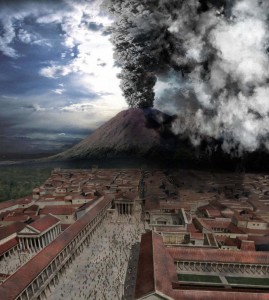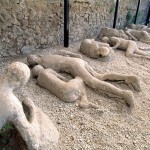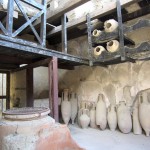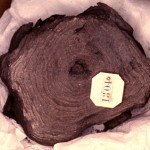Vesuvius and the buried treasures of Herculaneum
August 24, 2013/in Blog/by admin
Around 1:00 p.m. on August 24, 79 A.D., Vesuvius exploded over the Bay of Naples, shooting a column of pumice, ash and fumes 20 miles into the sky at a rate of 1.5 million tons per second, turning the sky black and releasing more thermal energy than 100,000 Hiroshima atomic bombs. There was no lava, since the eruption was too violent. There had been a few earthquakes before the blast, and most of the people living in the surrounding towns of Pompeii and Herculaneum had already fled their homes, but those who remained met a tragic end. Some had tried to escape by boat but were no luckier, and either perished in the boiling seas or in the tsunamis that followed the blast.
Within a half a day, Pompeii was destroyed and buried under a bed of debris, while Herculaneum was struck by a pyroclastic surge, a mix of ash and hot gases that swept through the town at 100 mph (160 kph). What was once a thriving center of the Roman empire became a wasteland that lay uninhabitable for 300 years. Pompeii was the bigger of the two towns, and is now the most famous, but Herculaneum was much better preserved and is now one of the most important archaeological sites of the Ancient World.
Pompeii is visited by 2.5 million people per year
Pompeii: about 2,000 people died in Pompeii, out of a population of 20,000. Many of the bodies left cavities in the tufa rock that have been cleverly made into casts, giving us precious insight into the tragedy. Some are so detailed you can see eyebrows, clothing, and the objects they clutched as they fled. The volcano’s wrath flattened the city, destroying anything above a first-floor level.
Casts of the bodies found at Pompeii
Herculaneum’s fate was quite different, as it was hit by a surge of ash and intense heat reaching some 932 °F (500 °C). Those citizens who had remained had gathered in massive stone arches by the seaside, hoping to be safe from falling debris, but they instead died instantly from the heat. The city was then buried under 75 feet (25 meters) of dense ash that formed an airtight seal over everything below, thus preserving houses, shops, and even organic matter. Archaeologists recently discovered a cache of 300 skeletons huddled in the seaside warehouses (a rare find since Romans usually cremated their dead), which provide valuable information on life in Roman times. We can even tell what they ate, and how they prepared it!
Two-story houses and even roofs were preserved in the ash
A British archaeologist made a fascinating one-hour video about it (click here), it's well worth your time!
A shop, with amphora in a wine rack The inhabitants huddled under the arches for safety
Near the ruins of Herculaneum you can visit the "Virtual Museum," with light shows and re-constructions of the site as it was before the blast. Or, have a preview here!
---------------------------------------------------------------------------
Piecing together classical texts from fragments[/caption] Recent excavations have yielded another surprise find: a stash of 1,500 Papyrus scrolls containing everything from legal documents to long-lost works of classical antiquity. The scrolls were carbonized by the heat, but new technology is allowing scientists to read “through” the papyrus with spectral imaging. It is now the most important “library” of the Ancient World! You many not realize it, but Roman and Greek texts from the "Classical Age" played a huge role in the Renaissance and Europe's emergence from "the Dark Ages." See the fascinating book by Steven Greenblatt, "The Swerve," about how the discovery of Lucretius' "On the Nature of Things" revolutionized Western thought. Read about it here in The New Yorker.
Carbonized papyrus scrolls are hard to read!
For more on spectral imaging, see the detailed article from the IS&T Reporter
----------------------------------------------------------------------------
Mount Vesuvius has erupted more than 30 times since then, the last occurring during WWII in March 1944. Clouds of ash blew towards U.S. bombers as they headed toward German targets. 45 people were killed and 88 Allied aircraft based nearby were damaged.
--------------------------------------------------------------------------------------
Want to see it in person? Come join us in southern Italy in Amalfi or Sicily!
* Sicily Bike
* And remember, Naples is only an hour from Rome by high-speed train, and 2.5 hours from Florence, so it's the perfect side-trip for any of our Italian trips! ![]()

















